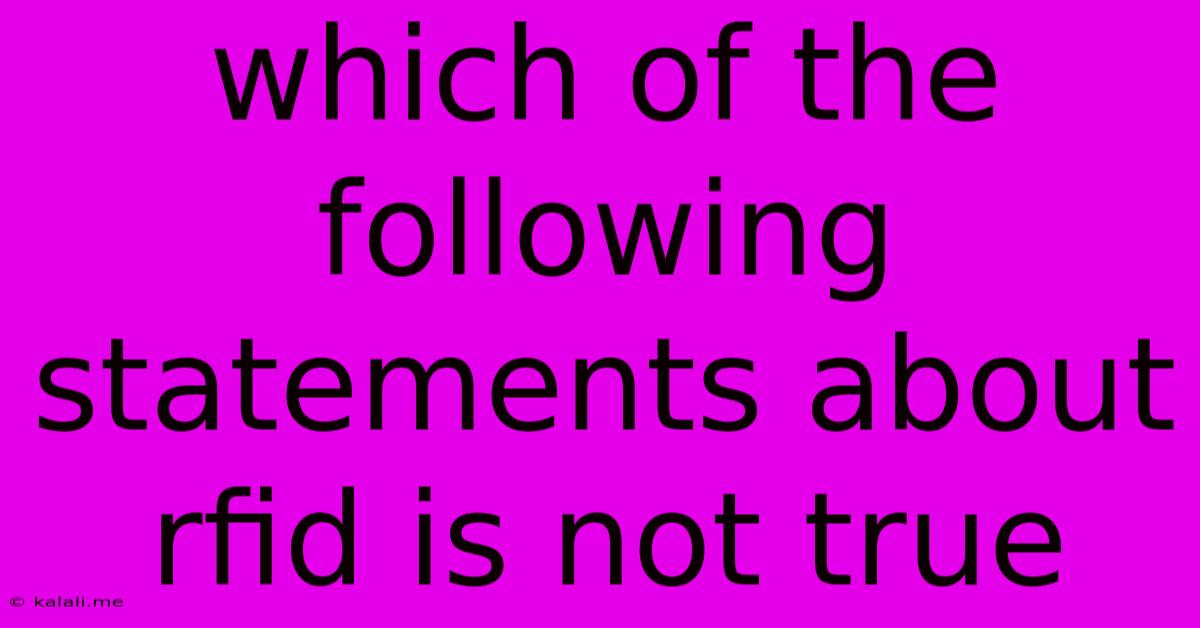Which Of The Following Statements About Rfid Is Not True
Kalali
Jun 14, 2025 · 3 min read

Table of Contents
Which of the Following Statements About RFID is Not True? Debunking Common Myths
RFID, or Radio-Frequency Identification, technology is transforming industries from supply chain management to access control. While its potential is vast, misconceptions about RFID persist. This article clarifies common misunderstandings, identifying the false statement among various claims and delving deeper into the technology's capabilities and limitations. This will help you understand RFID's true potential and limitations.
Understanding RFID Basics: Before we delve into the false statement, let's briefly review the core principles of RFID. RFID systems consist of two main components: tags and readers. Tags are small electronic devices containing a microchip and an antenna that transmit unique identifiers via radio waves. Readers capture these signals, allowing for the identification and tracking of tagged items.
Common Misconceptions about RFID: Several inaccurate statements circulate regarding RFID technology. Let's examine some of them:
-
Statement 1: RFID tags are easily cloned and duplicated. While it's true that some RFID tags are more vulnerable to cloning than others, modern RFID systems employ sophisticated encryption and authentication protocols to mitigate this risk. High-security RFID tags are incredibly difficult to clone, often requiring specialized equipment and expertise. This statement is generally considered false, particularly when discussing modern, secure RFID implementations.
-
Statement 2: RFID technology requires line-of-sight for reading. This is false. Unlike barcodes or QR codes, RFID readers can detect tags even if they are not in direct line of sight. This is because radio waves can penetrate various materials, like cardboard, plastic, or even wood, allowing for tracking of items within packaging or concealed locations.
-
Statement 3: RFID is only suitable for tracking high-value items. This is false. While RFID is certainly valuable for tracking high-value assets, its applications extend far beyond this. The cost of RFID tags has significantly decreased, making it an economically viable solution for tracking a wide range of items, including everyday consumer goods, library books, and even livestock. The scalability of RFID makes it suitable for managing large volumes of items, irrespective of their individual value.
-
Statement 4: RFID is a privacy risk and can easily be used to track individuals without their consent. This is a complex statement that needs nuanced consideration. While it's possible to misuse RFID technology for tracking individuals, modern privacy-focused RFID systems incorporate security measures that limit this risk. These include data encryption, access control, and the use of passive tags that only transmit data when actively interrogated by a reader. Therefore, while the potential for misuse exists, the statement that RFID easily tracks individuals without consent is generally considered false due to technological advancements and responsible implementation practices.
-
Statement 5: RFID technology is too expensive for small businesses. This statement is becoming increasingly false due to the decreasing cost of RFID tags and readers. While initially expensive, the technology is becoming more accessible to businesses of all sizes, offering a cost-effective solution for inventory management and other applications.
Conclusion: Many statements about RFID are based on outdated information or misunderstandings. While some concerns regarding security and privacy are valid and need to be addressed through responsible implementation, many claims about its limitations are inaccurate. Understanding the technology's true capabilities and limitations is crucial for effectively leveraging its potential across various industries. The statement that is generally NOT true amongst the common misconceptions is highly dependent on the specific context and implementation of the technology but generally centers around the ease of cloning, limited applications, high cost, and uncontrolled tracking of individuals. The specifics of which claim is 'not true' depend on the context, but the analysis above clarifies common misconceptions.
Latest Posts
Latest Posts
-
Which Of The Following Statements Is True About Ions
Jun 15, 2025
-
Who Wrote Sare Jahan Se Achha
Jun 15, 2025
-
Which Solution Is The Most Acidic
Jun 15, 2025
-
How Many Players In A Hockey Game
Jun 15, 2025
-
Is Stainless Steel A Homogeneous Mixture
Jun 15, 2025
Related Post
Thank you for visiting our website which covers about Which Of The Following Statements About Rfid Is Not True . We hope the information provided has been useful to you. Feel free to contact us if you have any questions or need further assistance. See you next time and don't miss to bookmark.